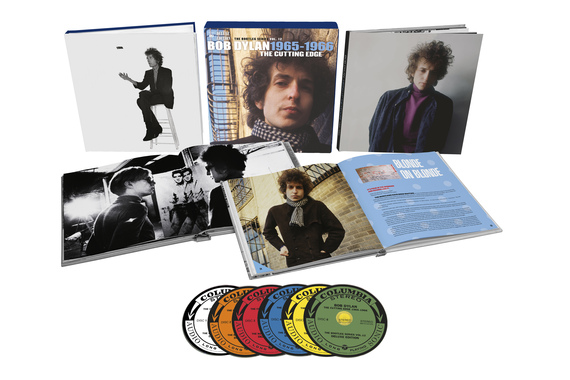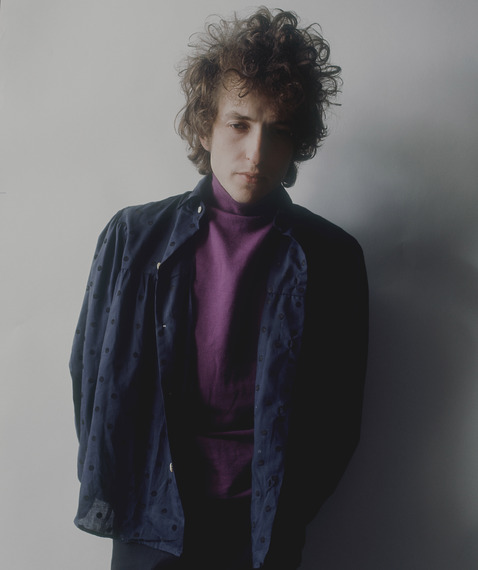Part Two of Two
You may only think you don't need to hear every single take of "Like A Rolling Stone," but you are quite mistaken. Dylan's work-in-progress on this song is flat-out wondrous to hear. The many takes of "Like a Rolling Stone" show its remarkable evolution from folk to rock to something far beyond. The first take of this song is almost a folk ballad, quiet and gentle -- Tom Wilson slates it as "CO86446, Like a Rolling Stone, One." Slow motion it surely is; I don't want to imagine swimming in lava, but that too must be doomfully slow. With amazement you realize you're listening to a waltz. Wilson even counts it out, like a dancing master: one-two-three, two-two three. Bob's presence is here in a plaintive, sweet harmonica, and his voice never comes in with a lyric, just the question, "It didn't get lost?" and the take ends. They all talk, and play, in the background, trying to figure out why. You try hard to figure out the voices, apart from Dylan's. Paul Griffin starts a rising line on his clattery tack piano, and they're onto something. The second take begins with his Dylan's voice, strong and barely accompanied with strumming strings, piano and touches of harmonica and organ. Dylan begins his tale as tales all used to begin, with "Once upon a time." The words, though, are still in progress. There's no "complete unknown" -- Dylan sings "sooooo unknown," before stopping the take coughing/ The song rolls out, slowly. "Be aware, doll," not beware. "You used to make fun about everybody that was hangin' out." "To be out on your own, so unknown, like a rolling stone." The take fades, and so does the folky sound, permanently. As Dylan said repeatedly at the time to people who tried to tag Highway 61 Revisited as "folk-rock," it isn't. He called it "the mathematical sound." This makes perfect sense as you listen to the takes of "Like A Rolling Stone." Dylan is looking for a rhythm, a meter, a pattern -- the shape of how the song, with words and music, could look on a page or a canvas, like a poem or a painting.
Later, Wilson says gently, "Okay, Bob, we got everybody here, let's do one, and then I'll play it back to ya, and you can pick it apart." Wilson knows the drill well by now. The song now slated as "Like A Rolling Stone, Remake, Take One," sounds like the version first released, right from the clicky drum start shared by Kooper's rolling, billowing keyboards. The lyrics are more set -- "when you're on your own, without a home, like a complete unknown, like a rolling stone." "Naw," says Dylan at the end of the first refrain, "we just gotta work that part out." They try again, but Bob has a false start, singing too softly. "Okay, rolling six," announces Wilson. Dylan is happier this time, at first, with a jingle-jangle sound, but then he hears something he doesn't like. "That's what I mean, that bump bump bump. . . okay let's cut it." Time and again, Dylan says, "no, no" and stops everyone to explain what it is he's wanting.
Finally, a complete take kick-starts with the drum alone, and the rest of the band following. This is the version we know best: the Woodyesque, folky pronounciation -- "stone" as "stawne" -- the line "no direction home;" and, in the last refrain, the magnificent second of silence, after Bob's first "how does it feel?," between the crash of the drum and Kooper's replying organ line. It fades into a jungly drumbeat and guitars turning plunky, being picked, it sounds like, as if they're banjos. Though this would be the album version, Dylan keeps on, with an edgier, snarkier version, slower; he punches out, and makes more nasal the "Now you don'ts," almost speaking them as if he's Rex Harrison, then stops abruptly. Dylan has to laugh on a subsequent try when he flubs a line, "threw the dumbs a dime, ha ha, let's take it again." On, and on. "Didn't youuuuu" -- Dylan strains for it, clears his throat, lets the harmonica come in for him. "You used to make fun about / everybody that was hanging out." He coughs. "My voice is gone, man, you wanna try it again?" That's the spirit. On they go, through the song, for a disc and a half of The Cutting Edge.
One of the glorious things about this record is the stem tracks. There are only four stems (or, properly, tracks) on any of these recordings, because CBS Studios, in 1965, used only a four-track audio tape recorder. The individual instruments stand not quite alone, since the mikes pick up some of the surrounding sounds, but on the stem recordings included on The Cutting Edge, you can easily hear just how good the musicians playing really are: Bloomfield's guitar, isolated on "Like A Rolling Stone." Paul Griffin's tack piano, and Dylan's guitar and vocal mike (often combined), shine in the increased detailing. This hasn't been done, of course, for all the songs, or The Cutting Edge would be a thousand tracks and more.
Dylan charged into Blonde On Blonde at the end of 1965, as soon as he had finished touring a shifting band of performers who ended up being Robbie Robertson, Levon Helm, Garth Hudson, Rick Danko and Richard Manuel. Levon and the Hawks became The Band, and their work on The Cutting Edge -- all together, and individually -- is one of the things that makes this record such a thing of beauty.
Dylan begins trying out new songs immediately, still-unwritten, just-forming songs. A song called "Freeze Out" -- or "Visions of Johanna" -- November 1965, one rehearsal, and one complete take. The madly pronoun-shifting spate of images and one-liners, pain and escape, "She's Your Lover Now," stands out for so many reasons. On the last of six takes, Dylan scraps the band, or The Band, and does the song alone, accompanying himself on the piano. For eight minutes and twenty-seven seconds, just Dylan, his voice and the keyboard: a spectacular, transcendent performance and my favorite recording out of all on The Cutting Edge.
Listening to Dylan writing songs, shaping the words to fit the music, is the best thing about the Blonde On Blonde sessions. Every single time, the songs are different, both lyrically and musically. He has come into the studio with ideas, not completed songs, and uses the instruments to realize what he wants to say. In late 1966, Dylan said, "my songs are pictures and the band makes the sound of the pictures." The takes of "Stuck Inside of Mobile With The Memphis Blues Again" show this perfectly. The Nashville blues, as he sings it once, go from a sketch to painted lines to a sweeping, color-filled fresco -- and you're sitting with your headphones on, amazed, listening to it happen. At the end of a searing, perfect take of "Leopard-Skin Pillbox Hat," you hear the studio sounds of a happy group of musicians. "Next," says Dylan, checking this one off, we've got it done. "Robbie, the whole world'll marry you on that one," says Charlie McCoy.
The 18-cd collector's edition of The Cutting Edge is overwhelming, and exhilarating. The joy of it is that now we get to listen, over and over, to songs we know by heart being made. The layers being laid down are painterly; we can hear drafts being written. For decades, Dylan's creative process has been a big part of his mystery and mythos. Now, he welcomes you in to one of the high times of his career -- days and nights that are rich and strange, full of the glory of making. "Live and in person," Dylan's tour posters used to say. "Don't you dare miss it." Here are three of the defining records of his fifty-year, and ongoing, career -- a slim slice of time from long ago and far away, feeling as fresh and wild as here and now, and as live and in person as you'll ever get to experience it. 
All images courtesy of Sony Music Entertainment.
Read my full review of The Cutting Edge here.

